Pawscessories is reader-supported. When you buy via links on our site, we may earn an affiliate commission at no cost to you.
Learn more.
If you are looking for a complete guide to the merle Bully, you have come to the right place. Because these dogs are quite rare people have a lot of unanswered questions about them.
In this post, we will cover everything from how Bullies get a merle coat, what they look like, their controversy, their maintenance requirements, their temperament, and much more.
We will also answer some of the most frequently asked questions about these dogs.
So, whether you are thinking about getting a merle Bully or just want to learn more about them, you’ll discover all you need to know here.
Let’s jump right in.
Table of Contents
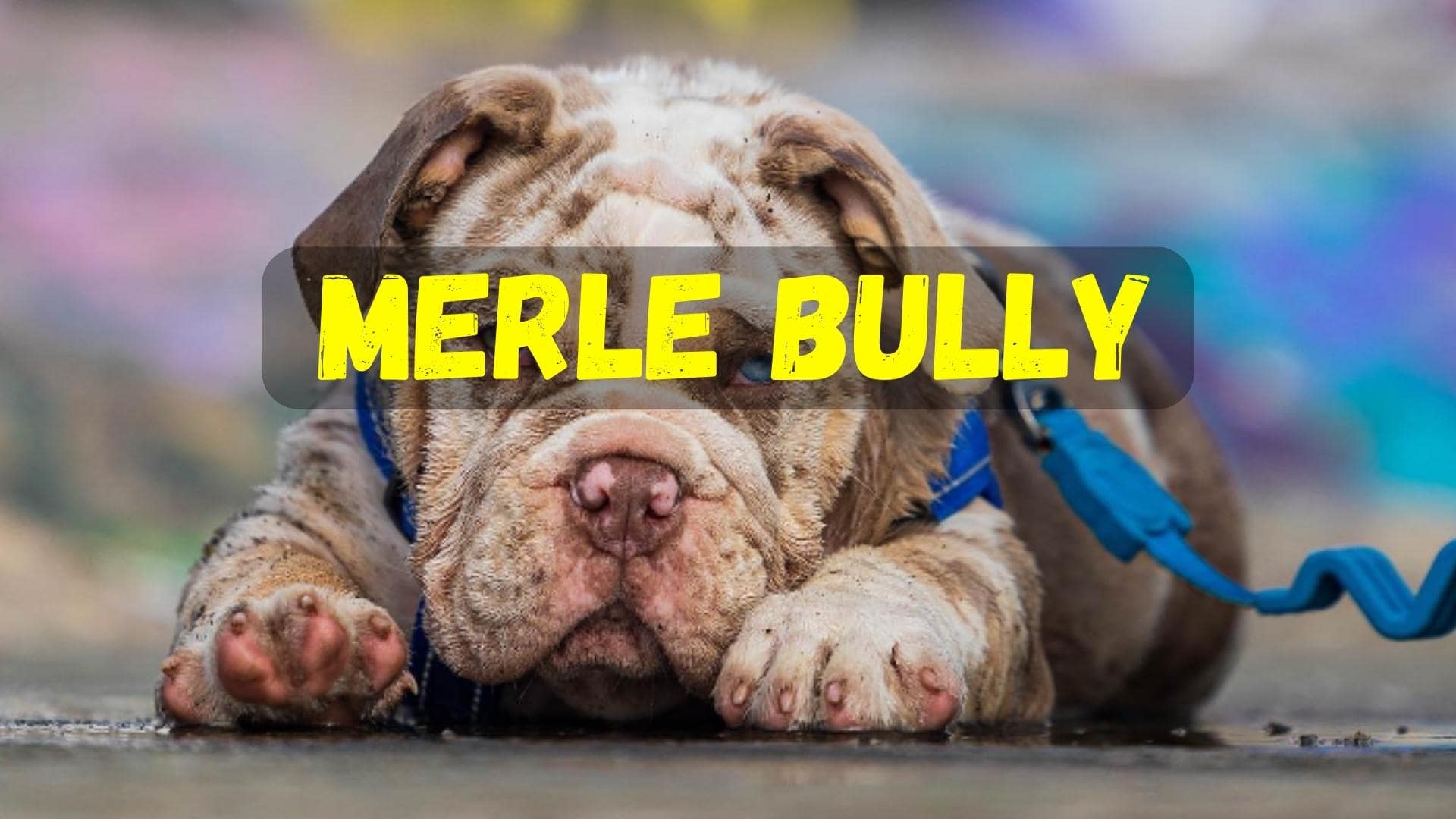
What Is a Merle Bully?
A merle bully is simply a bully dog with a merle coat. The merle coat pattern is characterized by random patches of color in a base coat of another color, usually black, blue, or red.
The merle gene creates a mottled appearance by diluting the colors of the dog’s coat.
This coat pattern is controversial among dog breeders.
Some believe that the merle gene is a genetic mutation that can cause health problems in dogs. Others believe that the merle coat pattern is a desirable trait that should be preserved.
How Does An American Bulldog Get a Merle Coat?
Similar to how a French bulldog develops a merle coat is the same for the American Bulldog. In order for a Bully to be born with a merle coat, one of their parents has to have the merle gene.
When one parent has the merle gene, their offspring can either inherit the unique merle coat or they can have a standard coat without any dilution.
Put simply, if neither parent has the merle gene, no puppies have a chance of getting a merle coat.
If one parent has the merle gene, some puppies will have the merle gene and others won’t.
If both parents have the merle gene, this is where complications take place and the reason for the controversy surrounding merle Bullies.
Why Is There Controversy Around Merle Bullies?
The controversy surrounding merle Bullies is primarily due to the health risks associated with the merle gene.
When two dogs who both carry the merle gene are bred together, there is a 25% chance that their puppies will inherit a double dose of the merle gene. Also known as a “double merle”
Double merle puppies are at risk for a variety of health problems, including deafness, blindness, and heart defects.
For this reason, many breeders believe that the merle coat pattern should not be bred into the Bully breed. However, others believe that the health risks associated with the merle gene can be managed through responsible breeding practices.
This is because not all merle puppies are born with these severe health problems. We’ll get into all the health issues associated with single and double-merled Bullies later.
Merle Bully Appearance & Traits
Size (Weight & Height)
The merle Bully comes in all the same sizes as the standard Bully. This includes Pocket, Standard, XL, and XXL.
The Pocket size is the smallest of the Bully breeds and usually doesn’t weigh more than 28 pounds (13 kg). They stand no taller than 14 inches (35 cm) at the shoulder.
Standard Bullies are between 29-50 pounds (13-23 kg), while XL Bullies weigh between 51-90 pounds (23-41 kg).
XXL merle Bullies are between 121-200 pounds (55-90 kg) and stand 24-26 inches (60-66 cm) tall at the shoulder.
Coat Colors & Texture
There are 4 coat color variations of merle Bullies, blue, chocolate, red, and ghost.
And while they are few categories of merle Bully, there are no two that look the same. However, the length and texture of their coats are the same.
The merle Bully’s coat is short, smooth, and dense.
Blue Merle Bully
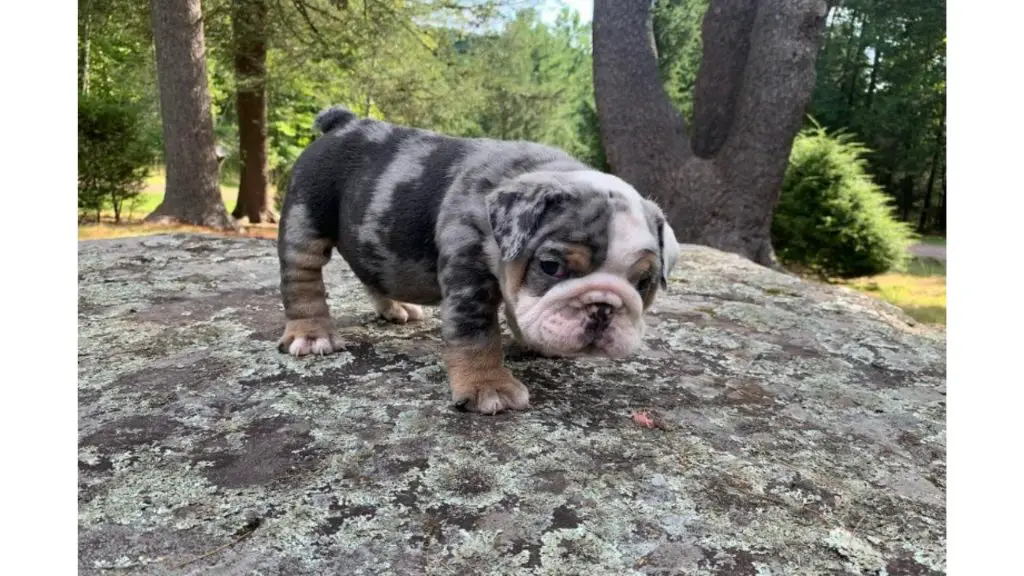
The blue merle Bully is the most popular and desired of the bunch. They have a bluish-gray base coat and primarily have patches of black but they can also have patches of brown or tan.
It’s also very common for them to have a white chest.
They are often confused with Tri Color Bullies as they have different colors mixed into their coat. But, the marble distribution is how they differentiate from other bullies with 3 separate coat colors.
Chocolate Merle Bully
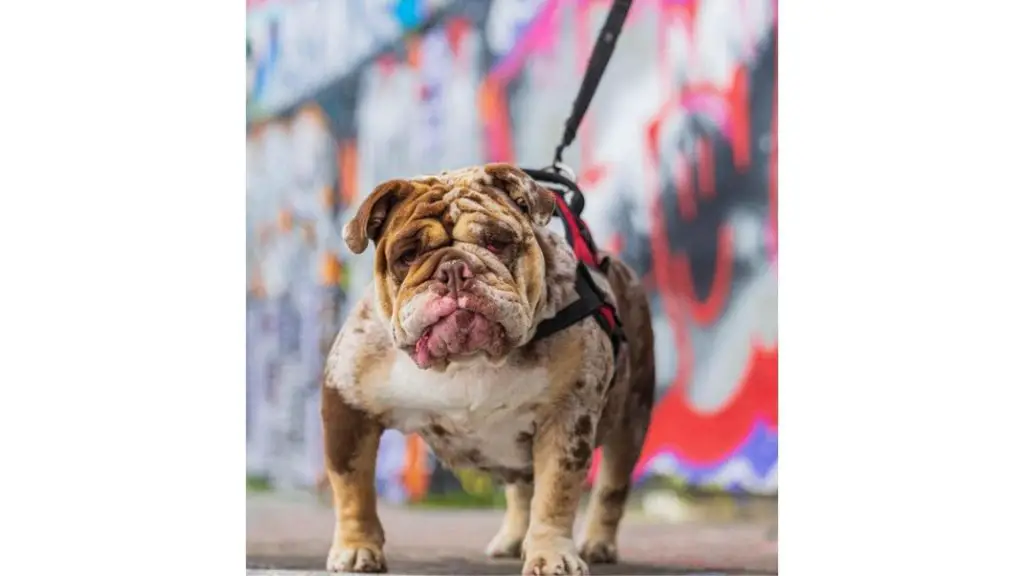
The chocolate merle Bully has a brown base coat color that is usually a deep dark brown but it can also be a little lighter.
Their patches are a distinctly different shade of brown while also having a white patch of fur on their chest.
Red Merle Bully
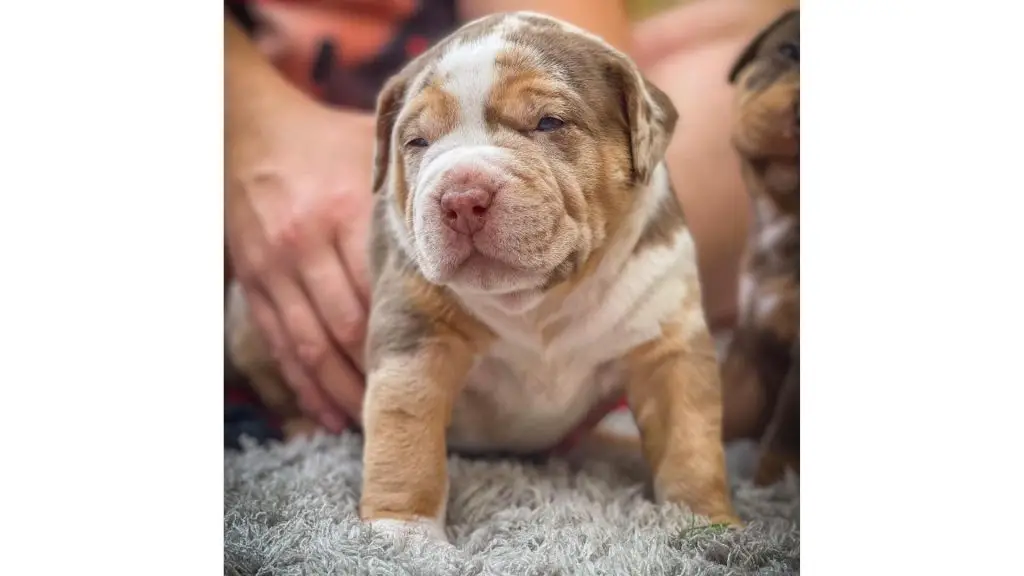
The red merle Bully is very similar to the blue merle, however, their base coat color is red (which is really a faint brown) instead of blue.
They will also have patches of brown along with a white chest.
Ghost Merle Bully
The ghost merle Bully is very different from the other merles. This is because they have no visible merle coat features that other merles do.
They are called “ghost” merles because they have the merle gene, but it’s not present in their coat.
So while they don’t look like other merles, if they were to be bred with another Bully that didn’t have the merle gene, their offspring could have the chance of inheriting a merle coat.
Shedding & Grooming
The merle Bully is a very low-maintenance dog when it comes to their coat.
They are moderate shedders and only need to be brushed once or twice a week. But, because of their short coat, they don’t require much more than that.
When it comes to bathing, you only need to do so when they get dirty or start to smell. Overbathing can strip the natural oils from their skin and coat which can lead to dryness and irritation.
A good bathing schedule for a merle Bully is every 8-12 weeks.
Their ears should be checked and cleaned on a regular basis to prevent any wax buildup or infection. And their nails will need to be trimmed every few weeks as well.
Lastly, they need to have their teeth cleaned/brushed a few times per week to ensure they don’t develop any form of periodontal (gum) disease.
Are Merle Bullies Hypoallergenic?
No, the merle Bully is not a hypoallergenic dog.
While they don’t have an undercoat, their short coat still sheds moderately. So, if you’re someone who’s allergic to dogs a merle Bully might not be the best choice for you.
Ears & Tail
The merle Bully has medium-sized ears that are set high on their head.
Their tails are thick and long, and they usually carry them low. But, when they’re excited or happy, their tails will raise up and curl over their back.
Eye Color
One of the most distinctive features of the merle Bully is their eyes.
They can have any color of eyes, but the most common are blue, green, and amber. And because of their merle coat pattern, they often have two different colored eyes (heterochromia).
This is due to the fact that the merle gene affects the pigmentation in their eyes which can cause one eye to be blue while the other is amber or green.
Lifespan
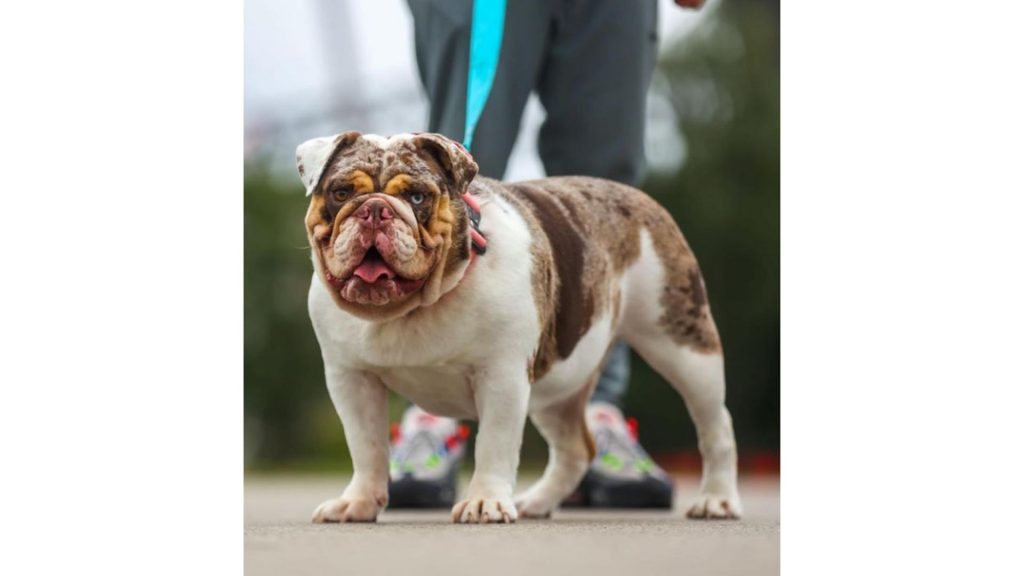
The merle Bully has an average lifespan of 10-16 years.
This is on par with the Bulldog’s average lifespan and is due to the fact that they share many of the same health concerns.
Common Health Issues
The health issues between single-merle Bullies and double-merle Bullies are quite different.
Single-merle Bullies are not susceptible to all of the same health concerns that double-merles are. How single-merle Bullies are affected is based on the lack of pigmentation in a portion of their coat.
The areas that are lighter and give them their unique merle appearance are more at risk for sunburn. So, for a single-merle Bully, it’s important to keep them out of the sun for prolonged periods of time.
Double-merle Bullies, on the other hand, are at a much higher risk for health issues due to the complete lack of pigmentation in their coat.
And while this makes them much more sensitive to the sun, double-merles are also prone to deafness, blindness, and heart problems. Which is why two Bullies with the merle gene should never be bred together.
In addition to these merle-related health concerns, Bulldogs in general have some health issues to be aware of.
These include:
- Hip dysplasia
- Elbow dysplasia
- Cherry eye
- Brachycephalic airway syndrome (BAS)
- Gastric dilatation volvulus (GDV) or bloat
- Hypothyroidism
- Demodectic mange
- Allergies
While these health concerns are not specific to the merle Bully, they are something to be aware of if you’re thinking about adding one of these dogs to your family.
Trainability & Intelligence
The merle Bully is a moderately intelligent dog. However, because of their stubborn and independent nature, they can be difficult to train.
This is why it’s important to start training them at a young age. And to be consistent with your commands and rewards.
Like all Bulldogs, the merle Bully needs a firm and patient owner who’s willing to put in the time and effort to train them. But, with patience and consistency, they can be trained to do tricks, obedience commands, and even more complex behaviors like cleaning up their own toys.
Activity Level & Exercise Needs
The merle Bully is not a high-energy dog. In fact, they’re quite the opposite.
These dogs love to lounge around and take naps. They’re content to lay on the couch all day, but they do need some daily exercise to stay healthy and happy.
A simple walk around the block in the morning and evening or a game of fetch in the backyard is usually all they need. But, if you have a particularly high-energy merle Bully, they may need a little more exercise than that.
It’s also important not to forget about mental stimulation for these dogs. Because they’re not super active, they can get bored easily.
So, make sure to give them plenty of toys and puzzles to keep their minds sharp. And, of course, plenty of love and attention.
Temperament & Behavior
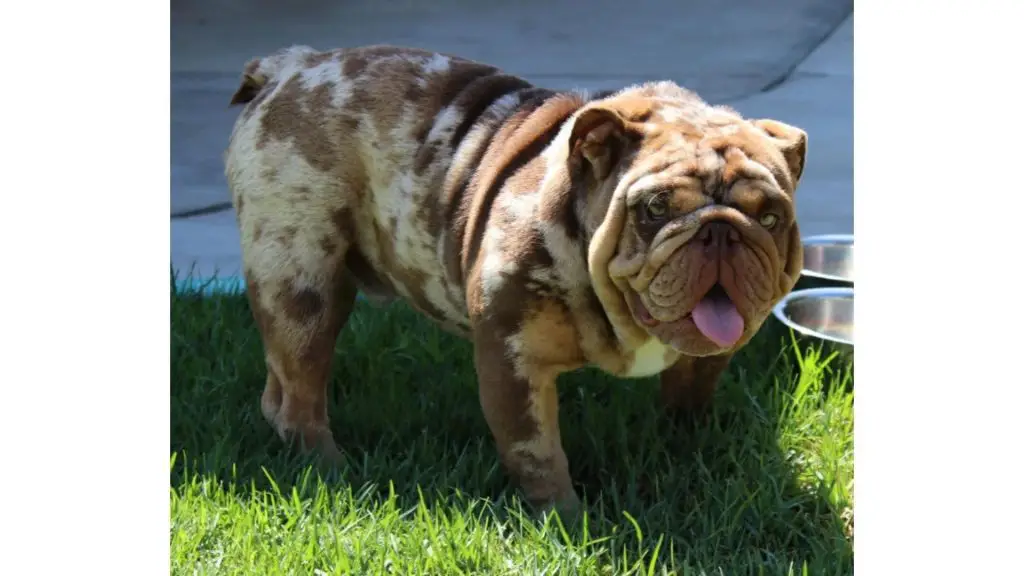
Do Merle Bullies Bark A Lot?
The merle Bully is not a particularly vocal dog. They will bark when they need to, but they’re not known for being yappy dogs.
This is good news for those looking for a relatively quiet dog. However, it’s important to note that all dogs bark from time to time and there’s no guarantee that a merle Bully will never bark.
Do Merle Bullies Like To Cuddle?
The merle Bully is a very affectionate dog. They generally love to cuddle and be close to their humans.
So, if you’re looking for a dog that will want to snuggle up with you on the couch, the merle Bully is a great choice.
Are Merle Bullies Good With Kids?
The merle Bully is generally good with kids. However, because of their independent nature, they can be a little aloof.
So, if you have small children in your home, it’s important to supervise them around the merle Bully. But, as long as they’re treated well, these dogs typically get along great with kids of all ages.
Are Merle Bullies Good With Other Dogs?
The merle Bully can be good with other dogs. However, because of their independent nature, they may not want to share your attention with another furry friend.
Of course, adequate socialization can always curb this behavior. But, it’s something to keep in mind if you’re thinking about adding a second dog to your home.
In terms of their behavior with other dogs outside your home, as long as they’ve been socialized they should enjoy playing with other canine friends.
Are Merle Bullies Good With Strangers?
The merle Bully is not particularly suspicious of strangers. However, they may not be as quick to warm up to new people as some other breeds.
This is why it’s important to socialize them from a young age. The more people they meet, the more comfortable they’ll be around new faces.
Are Merle Bullies Good Apartment Dogs?
The merle Bully is a good choice for an apartment dog. They’re not particularly active or overly vocal, so they don’t need a lot of space to run around and won’t be bothersome to neighbors.
And, as long as they get a daily walk and some playtime, they should be content to live in a small space.
Food & Diet
The merle Bully is not a particularly active dog, so they don’t need a lot of food.
A diet that’s high in protein and moderate in fat is typically best for these dogs. And, as with all dogs, it’s important to make sure they’re getting enough of the essential vitamins and minerals they need to stay healthy.
Of course, every dog is different and some may need more or less food than others. So, it’s always best to speak with a vet about what type of diet is best for any individual dog.
Generally, they should be fed two to three times a day.
Puppies under six months old should be fed three times a day. And, puppies between six and twelve months old can be transitioned to two meals a day.
How much food they need as they get older will depend on their activity levels, metabolism, size, and age.
Merle Bully Price

The price of a merle Bully will depend on the breeder, their location, the dog’s parents, whether they’re registered with a kennel club, and other factors.
Generally, you can expect to pay anywhere from $5,000 to $12,500 for one of these dogs.
So, if you’re looking to add a merle Bully to your family, be prepared to pay a pretty penny.
*IMPORTANT*
If a breeder attempts to sell you an “albino” or “white” Bully, avoid working with them. Double-merle Bullies have white coats and if a breeder is trying to sell you one claiming they are rare, one – they are clearly not a reputable breeder, and two – they’re lying.
Always make sure you are working with a reputable breeder.
It’s even more important when it comes to purchasing a merle Bully.
Other Merle Dog Breeds
Final Thoughts
The merle Bully is a beautiful and unique dog that will stand out in any crowd. They’re not for everyone, but if you’re looking for a loyal and loving companion, they may be the perfect breed for you.
Just be sure to do your research before purchasing one of these dogs and make sure you’re working with a reputable breeder.
This is especially important for merle Bullies as nonreputable breeders will breed two merle dogs to get a higher chance of having merle puppies and even try selling double merles as rare coat types.
So please, do your research, ask lots of questions, and find a reputable breeder before bringing home your new best friend.
Other posts you might find interesting:
The Tri Color Bully: Facts, Coat Colors, Cost & More!
Blue American Bully: FAQs, Pictures, Cost, Care Guide & More!
